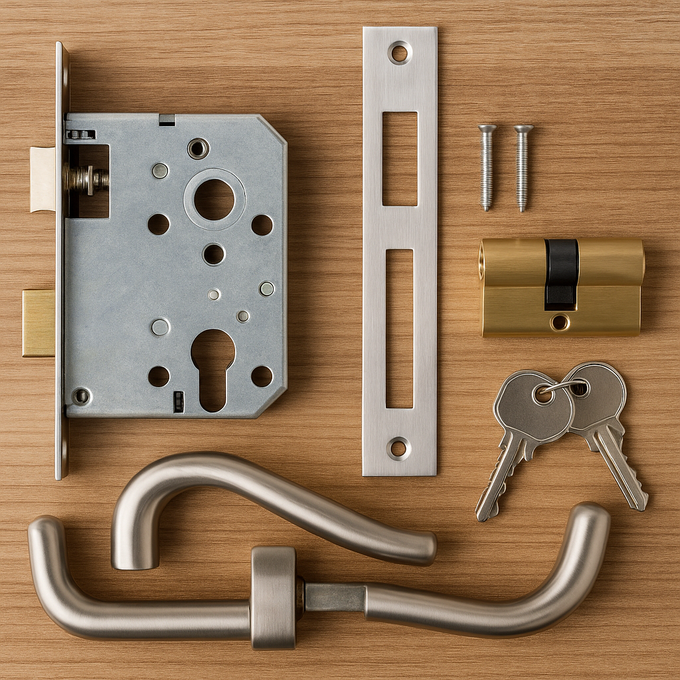
Mortise Locks 2025: Buying Guide for Homes & Businesses
Posted by National Lock Supply on Oct 9th 2025
If you’re a homeowner or business owner who wants the kind of “shut the door and forget about it” security that lasts for decades, mortise locks are still the gold standard in 2025. I’ve installed, repaired, and replaced thousands of them across houses, offices, schools, and hotels. This guide pulls together everything you need: the best residential picks, where to buy, how mortise compares to cylindrical, top commercial options, a plain-English explainer of how mortise locks work, and what it really takes to swap a mortise for a cylindrical lock (and whether you should).
I’ll keep the tone practical and friendly, but you’ll get the pro-level detail. Expect step-by-step notes, real-world use cases, and straight answers to the questions I hear most on jobsites and at kitchen tables.
What Are Mortise Locks?
A mortise lock is a premium type of door lock built to last a lifetime. Unlike standard cylindrical locks that fit through a simple round hole, a mortise lock sits inside a rectangular pocket—called a mortise—cut into the edge of the door. This design makes it stronger, more secure, and much more refined in both function and appearance.
Inside that mortised pocket is a solid lock body containing the latch, deadbolt, and internal mechanism. On the door’s faces, you’ll find the trim—usually a lever or knob mounted on decorative plates—and a cylinder, which is where the key or thumbturn operates the locking system. Together, they create a secure, serviceable assembly designed to handle decades of use.
Because of their internal construction, mortise locks deliver a noticeably heavier, smoother feel every time you turn the handle. They resist force better, distribute stress across the door frame, and can be repaired or re-keyed without replacing the whole unit—something most standard locks can’t offer.
What Matters Most When You Choose
Start with performance. The BHMA/ANSI grading system rates durability and security from Grade 3 (basic) to Grade 1 (highest). For most homes, Grade 2 mortise sets deliver excellent long-term reliability; if you want commercial-tier peace of mind, Grade 1 is the “set it and forget it” option.
Compatibility is next. Residential mortise backsets are typically 2-1/2" or 2-3/4". Match the backset your door is cut for, or plan on having a pro re-mortise the pocket. Confirm door thickness—most exterior doors fall between 1-3/4" and 2-1/4"—and check that both the lock body and trim support it. Determine handing from the outside (keyed) side: hinges on the left mean a left-hand door, on the right a right-hand door. Many mortise bodies reverse in the field; trim often does not, so verify before you order.
Finally, think about the cylinder and the look. A standard cylinder is fine for typical residences; a high-security cylinder adds pick and drill resistance plus key control so duplicates can’t be made without authorization. As for style, mortise trim is hardware you see and touch every day—choose a lever or knob profile and finish that fits your home’s design and the rest of your door hardware package.
The Best Fits by Use Case
Best all-around for most homes.
A Grade 2 mortise body paired with forged trim and a standard, upgradeable cylinder gives you smooth action and long service life without overspending. It’s ideal for primary entries and will offer wide finish and lever options to match your hinges and accessories.
High-security entry.
If you want maximum resistance to brute force and attacks on the cylinder, choose a Grade 1 body with a high-security cylinder, hardened inserts or protective plates, and a reinforced strike anchored with 3" screws into the framing. You’ll pay more upfront, but the longevity and key control are excellent.
Design-first or historic homes.
Go with solid brass trim on a traditional escutcheon and a period-correct lever or knob, backed by modern internals. You’ll get the tactile feel and authenticity you want without sacrificing reliability. Specialty finishes can carry longer lead times, so plan.
Smart-ready mortise (hybrid approach).
Prefer keypad, app, or card access? Pair a mortise body with smart-capable trim or a credential cylinder. You retain mortise strength while adding convenience for guests or service providers. Just check battery access, cold-weather performance, and how the system handles temporary codes and activity logs.
Sizing and Handing: Get These Three Details Right
Measure the backset from the center of the spindle or key cylinder to the door edge; expect 2-1/2" or 2-3/4". Confirm door thickness at the lock location and ensure the body and trim support it. Determine handing from the exterior side: hinges left = left-hand; hinges right = right-hand. If you’re replacing an existing mortise, photograph the current setup and note brand markings—this helps match case size and thru-bolt locations.
DIY or Hire a Pro?
Swapping a mortise for a mortise is straightforward when the prep matches. New mortise installations typically require a plunge router, proper jigs, and careful layout; most homeowners hire a professional to ensure alignment and long-term reliability. Whatever you choose, use the reinforced strike that ships with the lock and drive 3" screws into the framing for a real security upgrade. A once-a-year check—tighten set screws and lubricate with a manufacturer-approved product—keeps things silky.
Where to Buy Online in the U.S.
You can find mortise locks across the web, but not every seller handles handing, backset, and cylinder options with equal care. For a curated selection with technical specs and support, start at National Lock Supply and browse their mortise locks category to compare bodies, trims, and cylinders. You’ll also find manufacturer-authorized dealers and pro distributors useful for Grade 1 builds or bulk orders, while local locksmiths with online stores can key multiple doors alike or set up a small master key system.
Bulk and Small-Project Ordering Tips
If you’re outfitting several doors, prepare a simple door schedule: room name/number, handing, thickness, function (entrance, privacy, passage, storeroom), and finish. Ask about key control and master-keying, and confirm lead times—especially for specialty finishes or larger quantities.
Frequently Asked Questions
Are mortise locks more secure than cylindrical locks?
Generally, yes. The larger, reinforced case spreads force better, and Grade 1/2 mortise assemblies typically endure more abuse than equivalent cylindrical sets.
Can I retrofit a mortise into a door with a standard cylindrical bore?
Yes, but it isn’t a drop-in swap. You’ll need to cut a new mortise pocket and address the old 2-1/8" bore. Most homeowners bring in a pro for this.
Is it safe to buy high-security cylinders online?
It is—purchase from authorized sellers and complete the key-control registration so duplicates require authorization.
Can I add a smart keypad later?
Often. Choose a mortise body that’s compatible with smart trim or an access-control cylinder so you can upgrade without replacing the entire lock
 SAME DAY & EXPEDITED SHIPPING AVAILABLE
SAME DAY & EXPEDITED SHIPPING AVAILABLE





